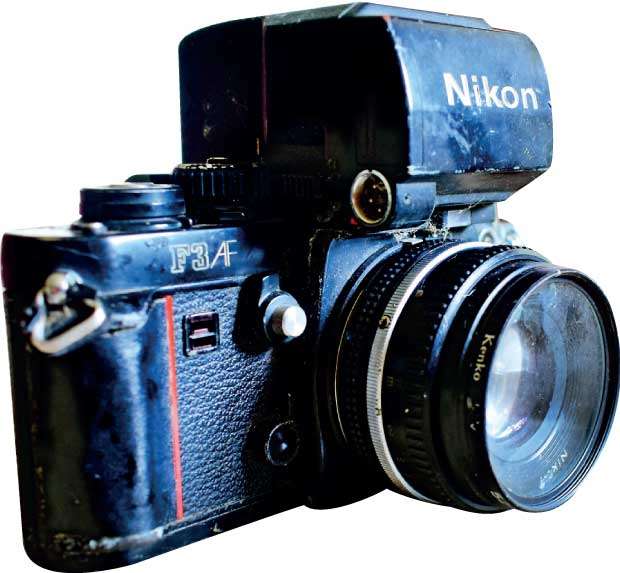Reply To:
Name - Reply Comment
Last Updated : 2024-04-23 11:51:00

“The old-fashioned camera was clumsier and harder to reload than a brown Bess musket. The modern camera is trying to be a ray gun.” (Susan Sontag, On Photography)
 Photography, which captures an instant for all eternity, has never before been so democratised in Sri Lanka. More than ever before, interest in it has soared greatly. Schools are forming societies and students are taking to those societies faster than ever. Even the teachers chosen to head them, while not exactly professionals in the field, are transcending their lack of awareness of the subject by learning with those students; in effect, they approach the field on pretty much the same terms. But while photography has become democratised and has long since been freed from the straitjacket of film rolls and darkrooms, it has also become misconceived in the eyes of those who think that all you do is apply your eye on the gadget and click away to your heart’s content. Once an art form like this becomes entangled in commercial necessity, moreover, it gets into the hands of those who profit from it, and to this end, photography, ideal when used in so many different ways, is confined to your birthday and wedding. Predictably.
Photography, which captures an instant for all eternity, has never before been so democratised in Sri Lanka. More than ever before, interest in it has soared greatly. Schools are forming societies and students are taking to those societies faster than ever. Even the teachers chosen to head them, while not exactly professionals in the field, are transcending their lack of awareness of the subject by learning with those students; in effect, they approach the field on pretty much the same terms. But while photography has become democratised and has long since been freed from the straitjacket of film rolls and darkrooms, it has also become misconceived in the eyes of those who think that all you do is apply your eye on the gadget and click away to your heart’s content. Once an art form like this becomes entangled in commercial necessity, moreover, it gets into the hands of those who profit from it, and to this end, photography, ideal when used in so many different ways, is confined to your birthday and wedding. Predictably.
Because filters are so readily available – sometimes they’re IN the camera – and because so many accessories can be purchased from the market at dirt cheap prices, the photographer tends to become lazy, and that by instilling in him an attitude of complacency. He or she no longer has to hassle around and control the environment he or she is in; the camera now does the job for him. Colours are lushly available, extravagantly so, and even when he resorts to monochrome, the effects are calculated to the dot because the camera can, or so the photographer believes, do everything for him. This is a field that developed the first time we, or rather our ancestors, stepped out of Plato’s Cave and encountered the world of mimesis, or material reality. We got obsessed with recording that reality, and the primitiveness of the technology of the first few cameras and camera firms helped us understand the reality we inhabited a way that modern cameras cannot.
Making reality easier to bear
The advantage with technology is that it makes that reality easier to bear. The disadvantage is that it cuts down on life spans. A refrigerator my mother bought 30 years ago broke down only last year, while its successor, of the brand new, carefully labelled, shiny variety, hiccups barely eight months after we got it. The same can be said of cameras: they used to be so heavy and yet so strong, like the Nokias and the old phones we still have with us, and they lasted longer too. They were harder to bear, but easier to part with, because by the time they were done, we were done with them and could gracefully bid farewell to them. That’s something most digital photographers will not experience, because at most, and with careful use, the new equipment can’t last for more than seven or eight years. Technology has liberated us in one respect, but killed us off in many others.
That’s something most digital photographers will not experience, because at most, and with careful use, the new equipment can’t last for more than seven or eight years
Most youngsters I know, who get a camera for their birthday or on account of getting good marks or simply due to the fact that their fathers and mothers and grandparents were photographers, click away at the most mundane things: flowers in their garden, cobwebs in their rooms, the dust-laden surfaces of their bookshelves, or even some incongruous item, like a camera lens, on their hands. The learning curve they have to experience steps in after a few months or so, when they learn that pictures of pretty flowers tell as much about the world as the shallow profundity of an art house movie; you think those flowers convey so much when you first take them, but after you develop it or download it on your computer and laptop, you and more pertinently your friends and audiences realise that there’s nothing extraordinary or compelling about your pictures.
Like advertising, photography thrives on the new and the unfamiliar, on ideas that have never been explored properly before. In the early days, for instance, you had separate film reels for separate ISO counts – from 200 to more than 6400 – but today everything’s packed into a little device, so before you get to the new and the unfamiliar you have to get used to the many features and options that your device has. In other words, back then the norm was for you to try out your camera, with its limited features, on backdrops and environments that worked best with the features and settings you had. A reel with an ISO count of 200 worked best at daytime, for instance, while a reel with an ISO count of over 1000 worked best in the evening right until dawn. Even then you had to factor in a ton of other exogenous factors, including the lighting, the kind of face your intended subject had, and the event you had to photograph. The environment controlled you, in other words, and the camera supplemented the fact that it controlled you.
Modern cameras
The advantage with modern cameras, of course, is that they’re quite flexible, which means that the photographers become as flexible as the devices they hold and carry. Cartier-Bresson hated colour, and he was eccentric in many other ways when it came to his field, including his obsession over the Leica, the camera he had and used all his life (owing to its discreet nature: unobtrusive, it could be handled in almost every setting imaginable, and it passed by unnoticed), as well as his aversion to taking pictures on commissions (barring certain exceptional circumstances). In Cartier-Bresson’s work, particularly his early work, when he was still taken up with painting, there is a subtle admixture of the picturesque and the real, sometimes the surreal, and this came out despite, or I may say, because of those eccentricities and individual quirks. Digital photography has, thankfully at one level, perhaps not so at another, done away with the need for quirks like this; in the hands of amateurs, the present day Nikons and Canons transform their users into event, landscape, and profile photographers at will.
In the good old days, there were quite obviously fewer photographers; now everyone with the necessary funds can buy the equipment and, over a certain period of time, master that equipment well. When that happens, even in other art forms, individuality gets lost and the vast majority of the artists (as they like to call themselves) turn towards the more profitable and popular avenues. In photography, these avenues include the birthday and the wedding, and in Sri Lanka, that birthday and that wedding have been supplemented by ad hoc companies and organisations which channel and sustain their popularity and profitability, through social media: Facebook is chock-a-block with such companies, some of which have been started by those still at school.

This is where the individual artist triumphs. Tired and disillusioned at the way photography has been monopolised by the event and corporate photographer, the true artist rises above all of that and carves out a different path. If it’s difficult to come up with a contemporary Weegee or Walker Evans or Bresson or Stanley Kubrick, it’s because the few who worked in magazines and other commissions and became auteurs and artists did not face the kind of competition they would today. And yet, in Sri Lanka, since so many take to commercial streams in the field, there is still hope left for another Weegee or Walker Evans to come up. The adults, of course, will find their way in this respect, but I am more concerned and interested in the young, since the young tend from their school-going days to take to the kinds of photography that help them earn more money.
Like advertising, photography thrives on the new and the unfamiliar, on ideas that have never been explored properly before
This latter tragedy – one of the inevitabilities of modernity, with its emphasis on specialisation and taking to what ensures stability – is best avoided by becoming more flexible, and to become more flexible, particularly if you don’t come from a family of photographers, is by testing your own talent at it, either by joining a photographic society (which in Sri Lanka is limited to your school or university), or by applying for a competition, or by doing both. I am unfortunately not aware of the competitions that are held annually, by schools and universities on the one hand and institutions and even photography firms on the other, in this country, but I am aware of one competition, and its organisers do a good job of bringing together workshops, quizzes aiming at the technicalities of photography, and an exhibition that recognises talent over technology. This is Pilibimbu, organised by the Photographic Art Society of Ananda College (established in 1946), which while not the oldest such in the country (other schools, like Royal, boast of Societies which predate it by a decade) is perhaps the only Society of its kind that actively promotes the art, and not merely the mechanics, of photography, here.
My point is this; if one is to discuss the art of photography, one has to start with our schools, and not just Ananda and Pilibimbu, if at all because that is where our photographers, especially those whose families don’t dabble in the field, come from. Much of what’s right, and wrong, with those who take to the subject can be traced to how these schools sustain their societies along with the members of those societies and their interest. Obviously, this calls for a series of sketches. Those sketches, I will present to you here. For now however, I am done.

Add comment
Comments will be edited (grammar, spelling and slang) and authorized at the discretion of Daily Mirror online. The website also has the right not to publish selected comments.
Reply To:
Name - Reply Comment
On March 26, a couple arriving from Thailand was arrested with 88 live animal
According to villagers from Naula-Moragolla out of 105 families 80 can afford
Is the situation in Sri Lanka so grim that locals harbour hope that they coul
A recent post on social media revealed that three purple-faced langurs near t